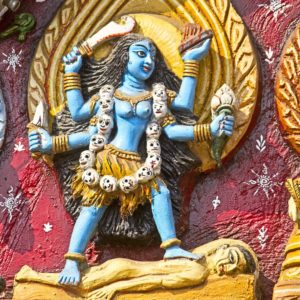
Most religions offer an interesting look at how cultures view the divine. The gods, goddesses, deities, spirits, and elementals of the many religions of the world are all drastically different. In Hinduism, most of the deities appear with multiple limbs and animal features. The goddess Kali, for example, has been shown with varying numbers of arms. In some works of art, she has four arms; others show her with up to 18. This is commonplace with the depictions of Hindu deities, and the goddess Kali symbolizes so much that the additional arms help to add to what she represents.
For outsiders, the name Kali might be somewhat familiar. Non-Hindus have seen her image in everything from video games to comic books, where she is usually referred to as a goddess of destruction and the end of the world. While this is definitely part of her personality, Kali also has a completely different side to her. In studying Kali and what she symbolizes, one is likely to uncover a lot of fascinating information about the contradictory nature of human beings and the importance of balance.
The Origin Story
All gods and goddesses have origin stories. These are their fantastic beginnings. Like most ancient deities, the goddess Kali has had several different stories surrounding her birth. One of the more popular tales explains that she was born during an intense battle between Durga, a goddess warrior, and Mahishasura, a demon who had the appearance of a buffalo. During this battle, Durga was said to have gotten so mad that her rage took form and burst from her body as Kali. Since she was the living representation of rage, Kali slaughtered all demons she came across. Most famously, she killed demon Raktabija.
Her power and anger got humans and gods alike worried. Her rage saw no discrimination, and anyone she believed to be doing wrong was subject to her fury. After killing a demon, Kali would put its head on a string and wear the heads around her neck. She is most often depicted with this necklace in classic and modern art. Her rampage eventually ended when the god Shiva the Destroyer laid in her path. Kali stepped atop Shiva and calmed down when she realized whom she was standing atop.
A Goddess With Many Sides
Many Hindu gods and goddesses are meant to represent multiple facets of the universe at once. The idea of the triumvirate is very big in Hinduism, with a large number of gods and goddesses appearing in groups of three. Kali is not associated with a trio, but she does embody a complex duality. Though her origin stories depict her as violent and associated with destruction, many also view her as a goddess of creation. There is a deep belief that creation cannot exist without destruction, and Kali is the living representation of that philosophy.
In her role as creator, Kali has found worshipers in many areas. Pregnant women and new mothers worship Kali for fertility purposes, while artists will turn to Kali for inspiration in their work. As a destroyer, she is more revered than outright worshipped. Her role in various stories shows her as a force to respect, and she is associated with being a “forbidden thing.” In Tantric Buddhism, Kali is a goddess that can help an individual to find salvation through confronting her and all that she represents.
Black and Blue
Kali is a fascinating goddess to both Hindus and non-Hindus alike. In her dance between destruction and creation, there is much to learn about the human spirit. Though her name is said to mean “night of death” and her skin is always depicted as being a deep black or blue, her presence can bring comfort to many. Whether she is slaughtering demons in a rage or helping expecting mothers to find peace, Kali will continue to represent all that is dark and light in humanity.

